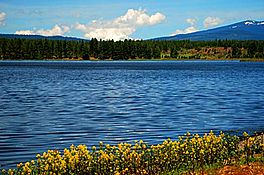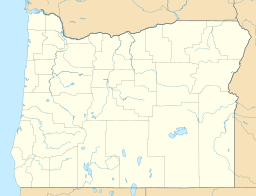John C. Boyle Reservoir facts for kids
Quick facts for kids John C. Boyle Reservoir |
|
|---|---|

Boyle Reservoir
|
|
| Location | Klamath County, Oregon |
| Coordinates | 42°08′24″N 122°02′01″W / 42.14000°N 122.03361°W |
| Type | Reservoir, eutrophic |
| Primary inflows | Klamath River |
| Primary outflows | Klamath River |
| Catchment area | 4,080 square miles (10,600 km2) |
| Basin countries | United States |
| Surface area | 381 acres (154 ha) |
| Average depth | 11 feet (3.4 m) |
| Max. depth | 45 feet (14 m) |
| Water volume | 4,200 acre-feet (5,200,000 m3) |
| Residence time | < 1 week |
| Shore length1 | 7.6 miles (12.2 km) |
| Surface elevation | 3,796 feet (1,157 m) |
| Settlements | Keno, Klamath Falls |
| 1 Shore length is not a well-defined measure. | |
The John C. Boyle Reservoir is a lake made by people. It is located in Oregon, USA. This lake was created by building the John C. Boyle Dam across the Klamath River.
You can find the reservoir about 16 miles (26 km) west of Klamath Falls. It is right along Oregon Route 66. The dam itself is about 10 miles (16 km) downstream from the town of Keno. A bridge called Spencer Bridge crosses the lake in the middle.
Water from the reservoir flows through a special channel. This channel leads to the Boyle Powerhouse, which is about 5 miles (8 km) downstream. The water is used to make electricity. The lake's water level can change by up to 3 feet (0.9 m) each day. This happens as water is stored or sent to the powerhouse.
Building the Reservoir: A Look Back
The John C. Boyle Dam was built in the mid-1950s. It was part of a bigger project called the Klamath River Hydroelectric Project. This project included several dams along the Klamath River. The California–Oregon Power Company (COPCO) built the dam. Later, COPCO joined with Pacific Power, which is now part of PacifiCorp.
The main reason for building the dam was to create hydroelectricity. This is electricity made from moving water. The reservoir can hold a lot of water, up to 4,200 acre-feet (5,200,000 m3).
The lake was first called Big Bend Reservoir. In 1962, its name was changed. It was renamed to honor John C. Boyle. He was an important person at COPCO. He worked as the company's vice president, general manager, and chief engineer.
Future of the Dam: Helping Salmon
The Boyle Dam is one of four dams on the Klamath River. These dams might be removed in the future. The other three dams are in California. They are called Iron Gate, Copco 2, and Copco 1. All these dams are owned by PacifiCorp.
Removing these dams would help salmon fish. For about 100 years, the dams have blocked salmon from swimming upstream. This has stopped them from reaching their natural spawning grounds. Taking the dams away would allow salmon to return and complete their life cycle. Many groups, including PacifiCorp, have discussed this plan to help the salmon. The United States Congress would need to agree for the dams to be removed.
Fun at the Reservoir: Recreation and Wildlife
The John C. Boyle Reservoir is a great place for outdoor activities. Many people enjoy fishing here. The lake is home to different kinds of fish. You can find largemouth bass that are usually 12 to 16 inches (30 to 41 cm) long. Other fish include black crappie, white crappie, yellow perch, brown bullhead, and pumpkinseed sunfish. You can fish from a boat or from the shore.
The Bureau of Land Management maintains a spot called Topsy Recreation Site. This site has a campground where you can stay overnight. There is also a boat launch, a dock, and a fishing pier. Besides camping and fishing, visitors can go swimming, have picnics, and enjoy bird-watching. It's a peaceful place to connect with nature.



